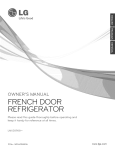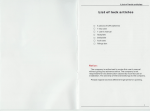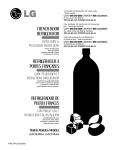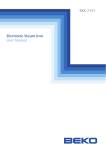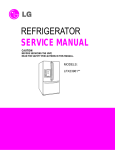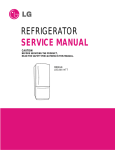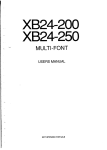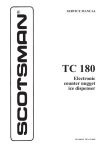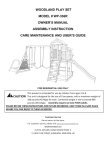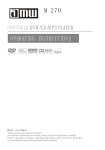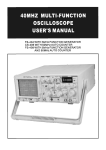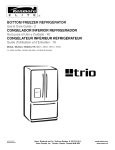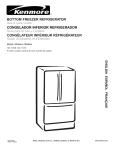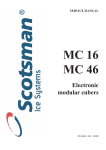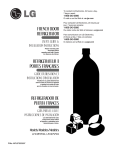Download po sFRANCAIsES
Transcript
To contact LG Electronics, 24 hours a day,
7 days a week:
1-800-243-0000
Or visit us on the Web at: us.lge.com
Pour contacter LG Electronics, 24 heures par
jour, 7 jours par semaine:
1-800-243-0000
FRENCH
DOOR Ou
visitez notre site Web a I'adresse: us.ige.com
REFRIGERAIOR
Para comunicarse con LG Electronics,
24 horas al dia, 7 dias a la semana:
USER'S
CUID[
_.
1-800-243-0000
O visitenos en la Web en: us.lge.com
INS[AHA[ION
INSMUCI+ONS
Please read this guide
thoroughly before
operating and keep it handy
for reference at all times.
RfFRIGERAIFUR
A
po sFRANCAIsES
cUiD[D'lj_IIUSAilON
El
iNsMUc
liONsDl+si,_tiAllON
Veuillez lire ce guide attentivement
avant la mise en service de I'appareil
et gardez-le & portee de main
pour le consulter en cas de besoin.
REFRIGERADOR
DE
PUERIA
FRANCES
cU[APARA
ElUSO
[
I+sii+UccIO+Es
DEINsiAb_cIO+
Lea detenidamente estas
instrucciones antes utilizar
el frigorifico y gua_rdelascomo
referencia para el futuro.
Models/Modelos/Modeles
LMX28g87**
P/No. MFL62184502
INIRODUCIION
IMPORTANT SAFETY INFORMATION
Basic Safety Precautions ........................................
CFC Disposal ..........................................................
3
4
How to Connect Electricity ......................................
5
PARTS AND FEATURES
f
THANK YOU!
Congratulations
Special Features .....................................................
Key Parts and Components ....................................
6
7
and welcome
on your purchase
to the LG family.
Your new LG French Door
INSTALLATION
Choose the Proper Location ...................................
Clearances ..............................................................
8
8
Refrigerator
Flooring ...................................................................
Handle Removal ......................................................
9
9
advanced
Door and Drawer Removal ....................................
10
Connecting the Water Supply ...............................
Connecting the Water Lines ..................................
18
18
Leveling the Refrigerator Doors ............................ 20
Starting ..................................................................
21
combines
cooling
technology
with simple operation
efficiency.
and high
Follow the operating
and care instructions
in this
HOW TO USE
Control Panel Features .........................................
22
The LED Display ...................................................
24
Adjusting the Temperatures and Display ............. 25
Operating the Dispenser ...................................... 26
Setting the Functions ...........................................
Spaceplus Ice System ..........................................
Automatic Icemaker .............................................
27
28
29
Storing Foods .......................................................
Location of Foods .................................................
30
31
Shelf Height Adjustment .......................................
32
CARE AND CLEANING
Removing and Replacing Components ................ 33
Cleaning the Refrigerator ..................................... 36
General Information ............................................. 36
Replacing the Water Filter .....................................
37
TROUBLESHOOTING
Before Calling for Service ..............................
38
SPECIFICATIONS
Key Dimensions and Specifications
..................... 42
WARRANTY
Product Registration Information .......................... 43
2
manual
and your refrigerator
will provide
you with many years
of reliable service.
J
IMPORIAN!
SAFELY
INFORMAIlON
BASIC SAFETY PRECAUTIONS
This guide contains
safety messages.
,_
many important
safety
messages.
Always
read and obey all
This is the safety alert symbol. It alerts you to safety messages that inform you of hazards that can kill
or hurt you or others or cause damage to the product. All safety messages will be preceded by the safety
alert symbol and the hazard signal word DANGER, WARNING, or CAUTION. These words mean:
DANGER
You might be killed or seriously injured if you don't follow instructions.
WARNING
You can be killed or seriously injured if you don't follow instructions.
&CAUTION
Indicates an imminently hazardous situation which, if not avoided, may
result in minor or moderate injury, or product damage.
All safety messages will identify the hazard, tell you how to reduce the chance of injury, and tell you
what can happen if the instructions are not followed.
WARNING
To reduce the risk of fire, electric shock, or
injury to persons when using your product,
basic safety precautions should be followed,
including the following.
Read all instructions before using this appliance.
• NEVER unplug your refrigerator by pulling on the
power cord. Always grip the plug firmly and pull it
straight out from the outlet.
• Repair or replace immediately all electric service
cords that have become frayed or otherwise
damaged. Do not use a cord that shows cracks or
abrasion damage along its length or at either the
plug or connector end.
• When moving your refrigerator away from the wall,
be careful not to roll over or damage the power cord.
• DO NOT store or use gasoline or other flammable
vapors and liquids in the vicinity of this or any other
appliance.
• Do NOT allow children to climb, stand, sit or hang
on doors, drawers or shelves of the refrigerator.
They could damage the refrigerator and seriously
injure themselves.
• Keep fingers out of pinch point areas; clearances
between the doors and cabinet are necessarily
small. Be careful closing doors when children are
in the area.
• Unplug your refrigerator before cleaning or making
any repairs.
NOTE: Service should be performed by a qualified
technician.
• Before replacing a burned-out light bulb, unplug the
refrigerator or turn off power at the circuit breaker
or fuse box in order to avoid contact with a live wire
filament. (A burned-out light bulb may break when
being replaced.)
NOTE: Some models have LED interior lighting and
service should be performed by a qualified
technician.
NOTE: Setting either or both controls to the OFF
position does not remove power to the light circuit.
• When you are finished, reconnect the refrigerator to
the electrical source and reset the control
(Thermostat Refrigerator Control, or Freezer
Control, or Freezer Control, depending on the
model) to the desired setting.
• This refrigerator must be properly installed in
accordance with the installer Instructions
that
were taped to the front of the refrigerator.
• After your refrigerator is in operation, do not touch
the cold surfaces in the freezer compartment when
hands are damp or wet. Skin may adhere to the
extremely cold surfaces.
• In refrigerators with automatic icemakers, avoid
contact with the moving parts of the ejector
mechanism or with the heating element that
releases the cubes. DO NOT place fingers or hands
on the automatic icemaking mechanism while the
refrigerator is plugged in.
• Do not modify or extend the power cord length.
It will cause electric shock or fire.
3
IMPORIAN!
SAFELY
INFORMATION
BASic SAFETY
PREcAUTiONS
(cONT.)
DO NOT refreeze frozen foods which have thawed
completely. The United States Department of
Agriculture in Home and Garden Bulletin No. 69
says:
...You may safely refreeze frozen foods that have
thawed if they still contain ice crystals or if they are
still cold--below 40°F (4°C).
...Thawed ground meats, poultry, or fish that have
any off-odor or off-color should not be refrozen and
should not be eaten. Thawed ice cream should be
discarded. If the odor or color of any food is poor or
questionable, dispose of it. The food may be
dangerous to eat.
Risk of Child Entrapment
Discarded or abandoned refrigerators are dangerous,
even if they will sit for just a few days. If you are
disposing of your old refrigerator, please follow the
instructions below to help prevent accidents.
Before you throw away your old refrigerator or
freezer:
• Take off the doors.
f
.......
• Leave the shelves in place
so that children may not
easily climb inside.
Even partial thawing and refreezing reduces the
quality of foods, particularly fruits, vegetables, and
prepared foods. The eating quality of red meats is
affected less than that of many other foods. Use
refrozen foods as soon as possible to save as much
of their quality as you can.
, WARNING
Tip-over
& Crush
Hazard!
Prevent
Fails!
\
• Do not sit or climb on freezer
drawers. Freezer can tip over
and crush you.
• Keep children away from
moving drawers. Stay back
when drawers are opening and
closing.
Moving parts can crush
and cut!
\
• Keep fingers away from front
and sides of moving drawers.
CFC DISPOSAL
Your old refrigerator may have a cooling system that
used CFCs (chlorofluorocarbons). CFCs are believed
to harm stratospheric ozone.
If you are throwing away your old refrigerator, make
sure the CFC refrigerant is removed for proper
disposal by a qualified servicer.
4
If you intentionally release this CFC refrigerant, you
can be subject to fines and imprisonment under
provisions of environmental legislation.
IMPORIAN!
SAFELY
INFORMAIlON
HOW TO CONNECT ELECTRICITY
f
IMPORTANT:
Please read carefully.
b
&WARNING
Electrical
Shock Hazard
For personal safety, this appliance must be
properly grounded. Have the wall outlet and
the circuit checked by a qualified electrician to
make sure the outlet is properly grounded.
J
RECOMMENDED
GROUNDING
METHOD
The refrigerator should always be plugged into
its own individual properly grounded electrical
outlet rated for 120 volts, 60 Hz, AC only, and
fused at 20 amperes. This provides the
best performance and also prevents overloading
house wiring circuits which could cause a fire
hazard from overheated wires. It is
recommended that a separate circuit serving
only this appliance be provided.
Use a receptacle which cannot be turned off with
a switch or pull chain. Do not use an extension
cord. Where a standard two-prong wall outlet is
encountered, it is your personal responsibility
and obligation to have it replaced with a properly
grounded three-prong wall outlet.
USE OF EXTENSION
CORDS
Because of potential safety hazards under
certain conditions, we strongly recommend
against the use of an extension cord.
However, if you still elect to use an extension
cord, it is absolutely necessary that it be a UL-listed
(USA), 3-wire grounding-type appliance
extension cord having a grounding-type plug
and outlet and that the electrical rating of the
cord be 20 amperes (minimum) and 120 volts.
Use of an extension cord will increase the
clearance needed for the back of the
refrigerator.
Do not, under any circumstances, cut or
remove the third (ground) prong from the
power cord.
Do not use an adapter plug.
NOTE: Some models have LED interior lighting and
service should be performed by a qualified technician.
When you are finished, reconnect the refrigerator to
the electrical source and reset the control
(Thermostat, Refrigerator Control, or Freezer Control,
depending on the model) to the desired setting.
SAVE THESE INSTRUCTIONS
5
PARISANDFEATURES
SPECIAL FEATURES
_Jl
f
CONTROL PANEL LED DISPLAY SCREEN
Simple electronic controls are user-friendly.
The LED screen shows refrigerator and freezer
temperatures, displays water filter status,
dispenser information, and more.
O
ICE PLUS
When this feature is activated, the freezer section
will run at the coldest temperature for a 24- hour
period to increase ice production by about 20
percent.
FILTERED WATER AND ICE DISPENSER
The water dispenser offers fresh, chilled, filtered
water through the door. The ice dispenser offers
cubed or crushed ice.
J
DOOR ALARM
A warning alarm sounds at 30-second intervals
when the refrigerator or freezer door is left open
for more than 60 seconds.
f
SPACEPLUS ICE SYSTEM
The icemaker automatically produces 80-130
ice cubes in a 24-hour period to keep the ice
dispenser fully supplied. The in-door design
creates more shelf space.
CRISPERS
LG's crispers preserve humidity and
help vegetables stay crisp.
AUTO CLOSING HINGE
When you slightly push the door of
the refrigerator, it is automatically closed.
(The door is automatically closed within
30 ° of the opening angle.)
J
GLIDE'N'SERVE
Provides storage space with a variable temperature
control that keeps the compartment colder than
refrigerator.
6
PARTSANDFEATURES
KEY PARTS AND COMPONENTS
In addition to the special features and components outlined in the Special Features section,
there are several other important components that are referenced in this manual.
_II
ADJUSTABLE
REFRIGERATOR
SHELVING
O
LED INTERIOR
LAMPS
The refrigerator compartment shelves are
adjustable to allow flexibility for storage needs.
Two separate LED arrays light the freezer and
refrigerator interiors.
GALLON STORAGE BINS
SHORT N'TALL BIN
Three interchangeable bins can be arranged to
suit your storage needs.
O
REMOVABLE
ICE STORAGE BIN
FIXED DOOR BIN
The ice storage bin can be removed to fill ice
buckets, coolers, or pitchers.
f
O
,J
7
INSIAllAIION
CHOOSE THE PROPER LOCATION
&WARNING
Excessive
Weight
• To reduce the risk of electric shock, do not
install the refrigerator in a wet or damp area.
Hazard
Two or more people are required when
moving and unpacking the appliance.
• Store and install the refrigerator where it will not
be exposed to temperatures below freezing or
exposed to outdoor weather conditions.
• Install this appliance in an area where the
temperature is between 55°F (13°C) and 110°F
(43°C). If the temperature around the appliance
is too low or too high, cooling ability may be
adversely affected.
• If this refrigerator is installed where the
temperature is above 110°F (43°C), the
freezing capacity is compromised and the cost
of electricity used increases.
• Select a place where a water supply can be
easily connected for the automatic icemaker
and dispenser.
• Unstable installation may cause vibration and
noise. If the floor is not even, make the
refrigerator level by rotating the height adjusting
screws.
• Properly ground the refrigerator to conform with
all governing codes and ordinances.
&CAUTION
Avoid placing the unit near heat sources,
direct sunlight, or moisture.
CLEARANCES
f
• Too small a distance from adjacent items may
result in lowered freezing capability and
increased electricity consumption charges.
Allow at least 24 in. (61 cm) in front of the
refrigerator to open the doors.
NOTE: For complete dimensions and specifications,
see page 42.
[
1" (2.54 cm)
J
8
INSIAllAIION
FLOORING
• To minimize noise and vibration, the refrigerator
MUST be installed on a solidly constructed
floor.
• To avoid vibration, the unit must be level. If
required, adjust the leveling legs to compensate
for unevenness of the floor. The front should be
slightly higher than the rear to aid in door
closing. The leveling legs can be turned easily
by pushing against the top of the refrigerator to
take the weight off the feet. Turn the leveling
legs clockwise to raise the unit or
counterclockwise to lower it.
• Carpeting and soft tile surfaces are not
recommended.
• Never install the refrigerator on a platform or
weakly supported structure.
NOTE: When moving the refrigerator for cleaning
or service, be sure to protect the floor. Always
pull the refrigerator straight out when moving it.
Do not wiggle or walk the refrigerator when trying
to move it; floor damage could occur.
NOTE: It is recommend that the doors be removed when it is necessary to move the refrigerator through a
narrow opening.
HANDLE REMOVAL
To move the refrigerator through a house door, it may be necessary to remove the refrigerator
door handles.
NOTE: Handle appearance may vary from illustrations on this page.
Mountinq
Fasteners
Set Screw
&CAUTION
• Use special care when removing handles to
prevent scratching the doors.
• The handle could be damaged if you hit it with
a hammer while removing or attaching.
• When you assemble or disassemble a handle,
you must push or pull with reasonable force.
Allen Wrench
Loosen the set screws with a 2.5 mm (3/32") Allen
wrench and remove the handle.
NOTE: If the handle mounting fasteners need to
be tightened or removed, use a 1/4" Allen wrench.
9
INSIAllAIION
HANDLE REMOVAL (CONT.)
HANDLE REINSTALLATION
f
_
Mounting
Fasteners
\
Place the handle on the door by aligning handle
footprints to fit mounting fasteners and tighten the
set screws with a 2.5 mm (3/32") Allen wrench.
NOTE: If the handle mounting fasteners need to
be tightened or removed use a 1/4" Allen wrench
DOOR AND DRAWER REMOVAL
DOOR REMOVAL
&WARNING
Electric Shock Hazard
• Disconnect electrical supply to the refrigerator
before installing. Failure to do so could result in
death or serious injury.
• Do not put hands or feet or metal sticks into the air
vents, base grille, or bottom of the refrigerator. You
may be injured or receive an electrical shock.
• Be careful when you work with the hinge, base
grille, and stopper. You may be injured.
Before you begin, remove food and bins from the
doors.
If your entrance door is too narrow for the refrigerator
to pass through, remove the refrigerator door and
move the refrigerator sideways through the doorway.
To remove the left refrigerator door:
Pull the water tube out of the fitting while
pressing the release ring on the fitting.
NOTE : When you pull out the tube, first you
have to push the collet by opposite direction
of arrow in the upper picture and pull the tube
out by direction of arrow.
10
INSIAllAIION
DOOR AND DRAWER REMOVAL (CONT.)
DOOR REMOVAL
(CONT.)
(2)
\
j(5)
(4)
/
J
(7)
/
(8)
• Open the door. Remove the top hinge cover
screw (1).
• Use a flat-head screwdriver to pry back the
hooks (not shown) on the front underside of
the cover (2). Lift up the cover.
• Remove the cover. Pull out the tube (3).
To remove the right refrigerator door:
• Open the door. Remove the top hinge cover
screw (1). Lift up the cover (2).
• Remove the cover.
• Disconnect the wire harness (3).
• Remove the grounding screw(5).
• Rotate the hinge lever (4) clockwise.
Lift the top hinge (5) free of the hinge lever
latch (6).
• Rotate hinge lever (6) counterclockwise.
Lift the top hinge (7) free of the hinge lever
latch (8).
IMPORTANT: When lifting the hinge free of
the latch, be careful that the door does not fall
forward.
IMPORTANT: When lifting the hinge free of
the latch, be careful that the door does not fall
forward.
• Lift the door from the middle hinge pin and
remove the door.
• Disconnect all the wire harnesses (4).
• Lift the door from the middle hinge pin and
remove the door.
• Place the door, inside facing up, on a nonscratching surface.
• Place the door, inside facing up, on a nonscratching surface.
11
INSIAllAIION
DOOR AND DRAWER REMOVAL (CONT.)
DOOR REINSTALLATION
Install the right-side door first.
• Lower the door onto the middle hinge pin as
shown.
• Fit the top hinge (1) over the hinge lever
latch (2) and into place. Rotate the lever (3)
counterclockwise to secure the hinge.
• Make sure the plastic sleeve is inserted in
the bottom of the door.
• Connect the wire harness (4).
• Hook the tab on the door-switch side of the
cover (5) under the edge of the wire opening
in the cabinet top. Position the cover into
place. Insert and tighten the cover screw (6).
(2)\\
Install the left-side door.
• Lower the door onto middle hinge pin.
(4)
• Fit the top hinge (1) over the hinge lever
latch (2) and into place. Rotate the lever (3)
clockwise to secure the hinge.
• Install the grounding screw (4) and connect
all the wire harnesses (5).
12
INSIAllAIION
DOOR AND DRAWER REMOVAL (CONT.)
DOOR REINSTALLATION
Cover
(CONT.)
Cover Screw
(6)....\
/
/
• Push the water supply tube (6) into the hole
on the top case and pull it through the
backplate.
Insert the water supply tube into the
connector.
• Insert the tube at least 5/8 in. (15 mm) into
the connector.
• Hook the tab on the door-switch side of the
cover under the edge of the wire opening in
the cabinet top. Position the cover into
place. Insert and tighten the cover screw.
&CAUTION
Collet
Tube
Insert Line
Clip --
1. Insert the tube until you can see only one of the lines printed on the tube.
2. After inserting, pull the tube to ascertain that it is secure.
3. Assemble the clip.
Correct
Incorrect
13
INSIAllAIION
DOOR AND DRAWER REMOVAL (CONT.)
FREEZER DRAWER
REMOVAL
&CAUTION
• To avoid possible injury or product or property
damage, you will need two people to perform the
following instructions.
• When laying the drawer down, be careful not to
damage the floor or hurt your feet with the sharp
edges on the hinge side.
• When you remove the drawer, do not hold the
handle. It may come off and could cause injury.
TOP DRAWER
14
To remove the freezer drawer, pull the drawer
open to full extension. Remove the drawer
and Ice bin by lifting the basket from the rail
system.
Remove the screws of the rail on both sides.
With both hands, hold both sides of the door
and pull it up to separate it from the rails.
With both hands, flex the center bar enough
to allow the gears on both ends to release
from the track.
_,CAUTION:
When you remove the drawer, do not hold the handle. If it may come off and it could cause
personal injury.
_,CAUTION:
When laying the drawer down, be careful not to damage the floor or hurt your feet by the
sharp edges on hinge side.
INSIAllAIION
DOOR AND DRAWER REMOVAL (CONT.)
FREEZER DRAWER REMOVAL
(CONT.)
&CAUTION
• To avoid possible injury or product or property
damage, you will need two people to perform the
following instructions.
• When laying the drawer down, be careful not to
damage the floor or hurt your feet with the sharp
edges on the hinge side.
• When you remove the drawer, do not hold the
handle. It may come off and could cause injury.
BOTTOM DRAWER
To remove the freezer drawer, pull the drawer
open to full extension. Remove the lower
DuraBase ® basket by lifting the basket from
the rail system.
_ Remove the screws of the rail on both sides.
/
J
With both hands, hold both sides of the door
and pull it up to separate it from the rails.
With both hands, flex the center bar enough
to allow the gears on both ends to release
from the track.
_,CAUTION:
When you remove the drawer, do not hold the handle. If it may come off and it could cause
personal injury.
_,CAUTION:
When laying the drawer down, be careful not to damage the floor or hurt your feet by the
sharp edges on hinge side.
15
INSIAllAIION
DOOR AND DRAWER REMOVAL (CONT.)
FREEZER DRAWER
REINSTALLATION
(CONT.)
kCAUTION
• To avoid possible injury or product or property
damage, you will need two people to perform the
following instructions.
&WARNING
Risk of Child Entrapment
• To prevent accidental child and pet entrapment
or suffocation risk, DO NOT allow them to play
inside of the freezer drawer.
• DO NOT step or sit on the freezer drawer.
TOP DRAWER
16
To reinstall the freezer drawer, hold the center
bar with both hands and pull it out until both
rails are fully extended.
Hook door supports (1) into rail tabs (2).
Lower door into final position and tighten the
screws (3). Make sure you have a right rail
cover for each side.
With the drawer pulled out to full extension,
insert the drawer and Ice Bin in the rail
assembly.
_,WARNING:
To prevent accidental child and pet entrapment or suffocation risk.
DO NOT allow them to play inside of drawer.
_,WARNING:
DO NOT step or sit down on freezer.
INSIAllAIION
DOOR AND DRAWER REMOVAL (CONT.)
FREEZER DRAWER REINSTALLATION
(CONT.)
kCAUTION
• To avoid possible injury or product or property
damage, you will need two people to perform the
following instructions.
&WARNING
Risk of Child Entrapment
• To prevent accidental child and pet entrapment
or suffocation risk, DO NOT allow them to play
inside of the freezer drawer.
• DO NOT step or sit on the freezer drawer.
BOTTOM DRAWER
f
To reinstall the freezer drawer, hold the center
bar with both hands and pull it out until both
rails are fully extended.
Hook door supports (1 into rail tabs (2).
Lower door into final position and tighten the
screws (3). Make sure you have a right rail
cover for each side.
With the drawer pulled out to full extension,
insert the lower basket in the rail assembly.
_,WARNING:
To prevent accidental child and pet entrapment or suffocation risk.
DO NOT allow them to play inside of drawer.
_,WARNING:
DO NOT step or sit down on freezer.
17
INSIAllAIION
CONNECTING THE WATER SUPPLY
&WARNING
Tools Required
• Standard
Connect
only.
to safe drinking
water supply
• The water pressure must be between 21 and
121 p.s.i. (1.5~8.5 kgf/cm 2) on models without a
water filter and between 43 and 121 p.s.i.
(3~8.5 kgf/cm 2) on models with a water filter.
• If water pressure does not reach 21 psi
(1.5kgf/cm _) or falls below, it is necessary to
purchase a separate pressure pump for normal
automatic icemaker and water dispensing
operation.
• It is recommended that the total length of the
water feed tube does not exceed 26 ft. (8 m).
• Install the water supply line where it will not be
affected by heat.
screwdriver
• 7/16-in. and 1/2-in. open-end wrenches or two
adjustable wrenches
• 1/4-in. nut driver
• 1/4-in. drill bit
• Hand drill or electric drill (properly grounded)
NOTE: Refrigerator dealers offer a kit with a 1/4-in.
saddle-type shutoff valve, a union, and copper
tubing. Before purchasing, make sure a saddletype valve complies with local plumbing codes.
Do not use a piercing-type or 3/16-in. saddle
valve which reduces water flow and clogs more
easily.
NOTE: The Commonwealth of Massachusetts
Plumbing Code 248CMR shall be adhered to.
Saddle valves are illegal and use is not permitted in
Massachusetts. Consult with your licensed plumber.
IMPORTANT: Read all directions thoroughly
before you begin.
• If operating the refrigerator before installing the
water connection, turn the icemaker to the OFF
position to prevent operation without water.
• All installations must be in accordance with local
plumbing code requirements.
• Use copper tubing and check for leaks.
• Install tubing only in areas where temperatures
will remain above freezing.
Cold Water
Supply
• The icemaker water valve contains a flow washer
which is used as a water pressure
regulator.
• The icemaker needs to be connected to a cold
water
line with water
pressure
between
21 ~121
psi (1.5~8.5 kgf/cm 2) on models without a water
filter and between 43 and 121 p.s.i. (3~8.5kgf/cm 2)
on models with a water filter.
• It may take up to 24 hours for the icemaker to
begin producing ice.
CONNECTING THE WATER LINES
IMPORTANT: Before connecting the tubing to
the water line, unplug the refrigerator or
disconnect the power.
• Turn off the main water supply and open the
nearest faucet to relieve pressure in the line.
Opening an outside faucet may help drain
water from the line in the house.
• To determine the length of copper tubing you
will need, measure from the connection on the
lower left rear of the refrigerator to the water
pipe. Add 7 ft. (2.1 m) to allow for moving the
refrigerator for cleaning. Use 1/4-in. O.D.
(outside diameter) copper tubing. Be sure both
ends of the copper tubing are cut square.
• Find a 1/2-in. vertical COLD water pipe near
the refrigerator.
• Using a drill, drill a 1/4-in. hole in the cold water
pipe you have selected.
NOTE: A horizontal pipe will work, but the
following precaution must be taken: drill on the
top of the pipe, not the bottom. This will help
keep water away from the drill and also keep
normal sediment from collecting in the valve.
18
INSIAllAIION
CONNECTING THE WATER LINES (CONT.)
• Fasten the shutoff valve to the cold water pipe
with the pipe clamp. Be sure the outlet end is
solidly in the 1/4-in. drilled hole in the water
pipe and the washer is under the pipe clamp.
Tighten the packing nut. Tighten the pipe clamp
screws carefully and evenly so the washer
makes a watertight seal. Do not overtighten or
you may crush the copper tubing, especially if
soft (coiled) copper tubing is used. Now you are
ready to connect the copper tubing.
• Slip the compression sleeve and the
compression nut onto the copper tubing as
shown. Insert the end of the tubing into the
outlet end squarely as far as it will go. Screw
the compression nut onto the outlet end with a
wrench. A flare nut wrench works best, but an
open-end wrench will suffice. Do not
overtighten.
• Place the free end of the tubing into a container
or sink, and turn on the main water supply.
Flush out the tubing until the water is clear.
Turn off the shutoff valve on the water pipe.
Coil the copper tubing as shown below.
Cold Water Pipe
Packing
Nut
Pipe Clamp
\
Coil of Polyethelyne
or Copper Tubing
Shutoff
Compression
Compression
IMPORTANT: Before connecting the tubing to the
refrigerator, be sure the refrigerator power cord is
not plugged into the wall outlet.
• Insert the end of the copper tubing into the
connection as far as possible. While holding the
tubing, tighten the fitting.
NOTE: If your refrigerator is equipped with an
internal water filter, an external in-line water filter
should not be used.
IMPORTANT: Tighten any connections that leak.
Open the water at the shutoff valve.
1/4'_
Tubing
• Plug in the refrigerator.
• Arrange the coil of copper tubing behind the
refrigerator so it does not vibrate against the
back of the refrigerator or against the wall.
• Check for leaks.
• Before connecting the water line to house, purge
house line for 2 minute.
NOTE: It may take a few seconds for water to
begin to flow as the internal tank fills and air clears
from the lines.
• Push the refrigerator back to the wall.
• Set the icemaker switch to the ON position.
Connection
• Remove the plastic flexible cap from the water
valve.
NOTE: The icemaker will not begin to operate until
it reaches its operating temperature of 15°F (-9°C).
It will then begin operation automatically.
NOTE: Throw away the first few batches of ice
(about 20 pieces).
• Place the compression nut and ferrule (sleeve)
onto the end of the tubing as shown.
19
INSIAllAIION
LEVELING THE REFRIGERATOR DOORS
&WARNING
&CAUTION
Electrical
• To avoid possible injury or product or property
damage, you will need two people to perform the
following instructions.
Shock Hazard
• Be careful when you work with the hinges,
base grille, and stopper. You may be injured.
• Do not put hands, feet, or metal items into
the air vents, base grille, or the bottom of the
refrigerator. You may be injured or receive
an electrical shock.
Leveling
After installing, secure the product with the LEG
not to move left or right.
Your refrigerator has two front leveling legs-one on the right and one on the left. Adjust the
legs to alter the tilt from front to back or side to
side. If your refrigerator seems unsteady or you
want the doors to close more easily, adjust the
refrigerator's tilt using the following instructions:
Level the refrigerator by using an 11/16 inch
(18mm) wrench or a flat blade screw driver.
Turn the leveling legs (CCW) to raise or (CW)
to lower the height of the front of the
refrigerator.
NOTE: The front of the refrigerator should be
slightly higher than the back.
NOTE: If someone pushes backward against
the top of the refrigerator, weight is lifted off of
the leveling legs, which makes adjustment
easier.
Kick Plate
Plug the power cord into a 3-prong grounded
outlet, and move the refrigerator into its final
position. Remove the kick plate screws and
then the kick plate.
• Open the Freezer Drawer.
• Once the drawer is open, there is sufficient
clearance to remove the screws on top of
the kick plate.
NOTE: To replace the kick plate, place it into
position, and then insert and tighten the
screws.
2O
Open both doors to make sure they close
easily. If not, raise the leveling legs higher by
turning both clockwise the same amount.
Once the refrigerator is level, replace the kickplate.
NOTE: Your new refrigerator is uniquely
designed with two fresh food doors. Either
door can be independently opened or closed.
You will have to exert slight pressure on the
doors to close them completely.
NOTE: In order not to move the refrigerator
back and forth, fix it with the 'Adjust' to the
floor to install and use.
INSIAllAIION
LEVELING THE REFRIGERATOR DOORS (CONT.)
DOOR ALIGNMENT
• Use the wrench (Included with the User Manual)
to adjust the bolt in the door hinge to adjust the
height. (CCW to raise or CW to lower the
height.)
STARTING
Before loading your refrigerator with fresh foods:
• Remove tape and any temporary labels from
your refrigerator before using. To remove any
remaining adhesive residue, rub the area briskly
with your thumb, or rub a small amount of liquid
dish soap over the adhesive with your fingers.
Wipe with warm water and dry. Do not use sharp
instruments, rubbing alcohol, flammable fluids,
or abrasive cleaners to remove tape or glue.
NOTE: Do not remove any warning-type labels,
the model and serial number label, or the tech
sheet that is taped to the back of the refrigerator.
• Install accessories such as the ice cube bin,
drawers, and shelves, in their proper places.
They are packed together to prevent possible
damage during shipment.
• Adjust the desired temperature for the
refrigerator and freezer (see Adjusting the
Temperature and Functions).
• Let your refrigerator run for at least 2 or 3 hours
before putting food in it. Check the flow of cold
air in the freezer compartment to ensure proper
cooling. Your refrigerator is now ready for use.
• Thoroughly clean your refrigerator and wipe off all
dust that may have accumulated during shipping.
21
HOW10 USE
CONTROL PANEL FEATURES
For complete details on button functions, see pages 25-27.
O
LED DISPLAY
The LED display shows the temperature
settings, dispenser options, water filter,
door alarm, and locking status messages.
ICE TYPE BUTTON
The ICE TYPE button is used to select Cubed Ice or
Crushed Ice.
FREEZER BUTTON
Press the FREEZER button to adjust the temperature
in the freezer compartment.
NOTE: When pressed simultaneously with the
REFRIGERATOR button for more than five seconds,
the temperature display will change from Fahrenheit
to Celsius or vice versa.
REFRIGERATOR
BUTTON
Press the REFRIGERATOR button to adjust the
temperature in the refrigerator compartment.
NOTE: When pressed simultaneously with the
FREEZER button for more than five seconds, the
temperature display will change from Fahrenheit to
Celsius or vice versa.
ICE PLUS BUTTON
Press this button to turn on the ICE PLUS. feature,
which increases icemaking capabilities up to about 20
percent.
O
LIGHT/FILTER
BUTTON
The LIGHT/FILTER button controls the lamp in the
dispenser.
The LIGHT/FILTER button resets the water filter
replacement indicator when the water filter has been
replaced.
22
ttOWlO USE
CONTROL PANEL FEATURES (CONT.)
O
ALARM/LOCK
BUTTON
O
LOWER BUTTON
Press this button to control the door-open alarm.
Press this button to lock or unlock all the other
Press the Freezer Lower button to open
and / or close the lower freezer drawer.
function buttons on the control panel, including
operation of the dispenser.
You can also open and close the freezer
drawer by pulling or pushing the drawer
with your hand.
UPPER BUTTON
Press the Freezer Upper button to open
and / or close the upper freezer drawer.
You can also open and close the freezer
drawer by pulling or pushing the drawer
with your hands.
@ CHILD
LOCK FUNCTION
This function will disable the Auto Drawer feature.
To activate the Child Lock Function press and
hold the Freezer Upper and the Freezer Lower
buttons simultaneously for 3 seconds.
To cancel the Child Lock Function press and
hold the Freezer Upper and the Freezer Lower
buttons simultaneously for 3 seconds.
23
ttOW10 USE
THE LED DISPLAY
The LED display shows the temperature settings,
dispenser options, water filter, door alarm, and
locking status messages.
O
DISPENSER SELECTION iNDICATOR
Shows Cubed ice or Crushed Ice selection
that will be dispensed when the push switch
is pressed.
e
FREEZER TEMPERATURE
Indicates the set temperature of the freezer
compartment in Celsius or Fahrenheit.
O
REFRIGERATOR
TEMPERATURE
Indicates the set temperature of the refrigerator
compartment in Celsius or Fahrenheit.
e
Q
iCE PLUS
When the ICE PLUS button is pressed,
the display will indicate the selected function
has been activated.
O
DISPENSER LIGHT INDICATOR
When the LIGHT button is pressed,
the display will indicate the selected function:
The dispenser light is on, this indicator will
appear on the display panel.
O
DOOR ALARM INDICATOR
This indicator shows that the
warning alarm is activated.
door-open
,CAUTION
Display
mode setting
and its cancellation
• With the refrigerator door open, keep pressing the
REFRIGERATOR button and ICE PLUS button
more than 5 seconds, then it goes to the display
mode.
• Perform the same way again to cancel the display
mode.
• All freezing units do not work at the display mode.
@ WATER
FILTER STATUS
This indicator shows the current status for
the water filter. See Resetting the Filter Indicator.
O
LOCK STATUS
This indicator shows the current status for
the control panel functions is set to LOCK.
24
HOW10 USE
ADJUSTING THE TEMPERATURES
Adjust
Freezer
AND DISPLAY
Temperature
Temperature
TO adjust the temperature in the freezer
compartment, press the FREEZER button to cycle
through the the range Of available settings.
Display
To Change the temperature display from Fahrenheit
to Celsius:
n
U°F
Adjust
Refrigerator
Temperature
To adjust the temperature in the refrigerator
compartment, press the REFRIGERATOR button to
cycle through the range of available settings.
• Simultaneously press and hold the FREEZER and
REFRIGERATOR buttons for more than 5 seconds.
• Do the same to convert back to Fahrenheit.
Power
Saving
Mode
NOTE: The actual inner temperature varies
depending on the food status, since the indicated
temperature setting is the target temperature and not
the actual temperature within the refrigerator.
Initially set the REFRIGERATOR CONTROL at 37
degrees F and the FREEZER CONTROL at 0
degrees F. Leave them at these setting for 24 hours
(one day) to stabilize. Then adjust the compartment
temperature as illustrated above.
• The display will remain off until the next time the
door is opened.
The display will also turn on when any button is
pressed, and it will remain on for 20 seconds after
the last door opening or button selection.
• To deactivate the Power-Saving Mode, press the
FREEZER and ICE PLUS buttons simultaneously
and hold them for 5 seconds until the tone sounds.
NOTE: Power Saving Mode function is set on the
product.
25
ttOWTOUSE
OPERATING THE DISPENSER
DISPENSING
CRUSHED ICE
DISPENSING
Press the ICE TYPE
button to illuminate the
Crushed Ice icon.
WATER
Press the push ice switch
with a glass or other
/_
/
Press the push water switch
with a glass or other container
and chilled water will be
dispensed.
When the water switch is pressed, the light will be
illuminated.
container and crushed ice
will be dispensed.
CONTROLLING
DISPENSING
WATER
CUBED ICE
THE DISPENSER
LIGHT
Press the LIGHT/FILTER
button to turn the dispenser
light on and off.
Press the ICE TYPE
button to illuminate the
Cubed Ice icon.
Press the push switch
with a glass or other
container
and cubed ice
will be dispensed.
NOTE: Hold the glass or other container in place
for a couple of seconds after dispensing ice or
water to catch the last few cubes or drops. The
dispenser is designed to not operate while either
refrigerator door is open.
WATER SWITCH
ICE SWITCH
&CAUTION
• When filling the container with a small opening, use it near the opening of the water or ice dispenser
as close as possible.
• Do not dispense ice into fine china or crystal glasses. China or crystal can break.
Incorrect
Correct
f
Water
Ice
26
ttOW10 USE
SETTING THE FUNCTIONS
Press the button for the desired function to view and
select other settings.
SETTING THE DISPENSER
LOCK
RESETTING THE FILTER INDICATOR
PreSS and hold the
ALARM/LOCK
button for three seconds
to lock the dispenser and
all of the other control panel
Press and hold the
LIGHT/FILTER button for more
than
water
......
n_t MONTH
_Z
i_]
functions. Press and hold
again for 3 seconds to
unlock.
SETTING THE DOOR ALARM
The ALARM/LOCK button
also controls the door
alarm that sounds three
times in 30-second
intervals when a
compartment
K1))
door
Press the ALARM/LOCK button once to activate
and deactivate the door alarm function.
NOTE: Contact your local service center
if the alarm continues to sound after the
doors are closed.
DIAGNOSTIC
to reset
filter
has
been
replaced.
CHANGE
NOTE: It is recommended that you replace the filter
when the water filter indicator light reaches 0 or
whenever the water or ice cube taste deteriorates
noticeably.
ACTIVATING
ICE PLUS
Press the ICE PLUS button
once to activate the ICE PLUS
function. The ICE PLUS icon on
is
left open for more than
60 seconds. The alarm
stops sounding when
the door is closed.
3 seconds
the filter indicator after the
the display panel will illuminate
when activated.
The ICE PLUS function runs the
.."__
freezer compartment at the
coldest setting for a 24-hour
period to increase icemaking by
up to about 20%, and then turns
off automatically.
NOTE: Press the button again to cancel
the ICE PLUS function.
FAILURE DETECTION
The diagnostic function automatically detects problems with your refrigerator, and a diagnostic code will
appear in the display. NOTE: If a diagnostic code appears in the display during use, note the code and
then call 1-800-243-0000
authorized servicer.
(24 hours per day/7 days per week) and select the option to locate an
27
ttOW10 USE
SPACEPLUS ICE SYSTEM
&CAUTION
• Keep hands and tools out of the ice bin door
and dispenser chute. You could break
something or injure yourself.
The icemaker will stop producing ice when the ice bin
is full. If you need more ice, empty the ice bin into the
extra ice bin in the freezer compartment so the
icemaker can keep producing ice.
Shake the ice bin occasionally to level the ice in it.
Sometimes the ice piles up near the icemaker,
causing the icemaker to misread the amount of ice
cubes and stop producing ice.
Push on the latch firmly where noted to close the
ice bin door; it will make a clicking sound when it
is closed completely.
NOTE: Storing cans or other items in the ice bin may
damage the icemaker.
Keep the ice bin door closed tightly. If the ice bin door
is not closed tightly, the cold air in the ice bin will
freeze food in the refrigerator compartment. This
could also cause the icemaker to not produce ice.
NOTE: If the On/Off switch on the icemaker is set to
Off for an extended time, the ice compartment will
gradually warm up to the temperature of the
refrigerator compartment. To prevent ice cubes from
melting and leaking from the dispenser, ALWAYS
empty the ice bin when the icemaker is set to Off for
more than a few.
To remove the Spaceplus Ice System, grip the
front handle, slightly lift the lower part, and slowly
pull out the bin as shown.
f
To reinstall the Spaceplus Ice System, slightly
slant the bin during replacement to avoid contact
with the icemaker.
28
Avoid touching the automatic shutoff arm when
replacing the ice bin. See the label on the ice bin
door for details.
HOW113USE
AUTOMATIC ICEMAKER
Ice is made in the automatic icemaker and sent to
the dispenser. The automatic icemaker can make 6
ice cubes at a time, 80-130 cubes per 24-hour
period. This quantity may vary by circumstance,
including freezer compartment temperature, room
temperature, number of door openings, freezer load,
and other operating conditions.
&WARNING
• It takes about 12 to 24 hours for a newly installed
refrigerator to make ice.
• DO NOT place fingers or hands on the automatic
icemaking mechanism while the refrigerator is
plugged in.
• Icemaking stops when the ice storage bin is full.
Personal
Injury Hazard
• Avoid contact with the moving parts of the
ejector mechanism or with the heating element
that releases the cubes.
• To turn off the automatic icemaker, set the
icemaker switch to OFF (O). To turn on the
automatic icemaker, set the switch to ON (I).
Icemaker
/
• The cube size will vary depending on the Water
Amount Selection Setting, as well as the water
pressure of the connected water line.
Aut
• You can regulate the cube size by pressing the
Water Amount Selection Button.
NOTE: It is normal that a noise is produced when
ice drops into the ice storage bin.
• Even when the water pipe is not connected and
the Ice Maker is turned on, the water valve
operates. The noise is generated because the
water pipe is not connected, which does not
mean the icemaker is defective.
Water
Shutoff Arm
Amount
Water
ON/OFF
Indicator
Lights
Amount
Selection
Button
Switch
NOTE: Raising the automatic shutoff arm does
not turn off the icemaker.
&CAUTION
• The first ice and water may include particles or
odor from the water supply line or the water tank.
• Throw away the first few batches of ice (about
20 pieces) and purge the water line for 2 minutes
after installation to eliminate air and odd tastes.
• This is also necessary if the refrigerator has not
been used for a long time.
• Never store beverage cans or other foods in the
ice bin for the purpose of rapid cooling.
Doing so may damage the icemaker or the
containers may burst.
• If discolored ice is dispensed, check the water
filter and water supply. If the problem continues,
contact an Authorized Service Center. Do not
use the ice or water until the problem is corrected.
• Keep children away from the dispenser.
Do not allow children to play in or around dispenser.
• The ice passage may also become blocked
with frost if only crushed ice is used. Remove
the frost that accumulates.
• Never use thin crystal glass or crockery to
collect ice. Such glasses or containers may
break, and glass fragments could be in the ice.
• Dispense ice into a glass before filling it with
water or other beverages. Splashing may occur
if ice is dispensed into a glass that already
contains liquid.
• Never use a glass that is exceptionally narrow
or deep. Ice may jam in the ice passage and
refrigerator performance may be affected.
• Keep the glass at a proper distance from the
ice outlet. A glass held too close to the outlet
may prevent ice from dispensing.
• To avoid personal injury, keep hands out of
the ice door and passage.
• Never remove the icemaker cover.
• If you find ice or water dispensed unexpectedly,
turn off the water supply and contact an Authorized
Service Center. Call 1-800-243-0000
(24 hours
a day, 365 days a year) and select the option to
locate an authorized servicer.
29
HOW10 USE
STORING FOODS
• Store fresh food in the refrigerator compartment.
Freezer
• How food is frozen and thawed is an important
factor in maintaining freshness and flavor.
• Do not store glass bottles in the freezer
• Do not store food that spoils easily, such as
bananas and melons, at low temperatures.
• Allow hot food to cool prior to storing; placing hot
food in the refrigerator could spoil other food and
lead to higher energy consumption.
• When storing food, cover it with vinyl wrap or store
in a container with a lid. This prevents moisture from
evaporating and helps food to keep its flavor and
nutrition.
3O
compartment
compartment;
are
glass
may
break
when
the contents
frozen.
• Do not refreeze food that has been thawed.
This causes loss of flavor and nutrition.
• Do not touch cold foods or containers, especially
those made of metal, with wet hands or place glass
products in the freezer compartment.
Refrigerator
compartment
Do not block air vents with food or containers.
Smooth circulation of chilled air keeps the
refrigerator temperatures even.
• Avoid placing moist food on the top refrigerator
shelves; it could freeze from direct contact with
chilled air.
Do not open the doors frequently. Opening the
doors allows warm air to enter the refrigerator and
freezer compartments, which causes temperatures
to rise.
• Always clean food prior to refrigeration.
Vegetables and fruits should be washed and wiped
and packed food should be wiped to prevent
adjacent food from spoiling.
Never overload the door racks; overloading may
push against the inner racks and prevent the doors
from closing correctly.
NOTE: If you keep the refrigerator in a hot and humid
place, frequent opening of the door or storing a lot of
vegetables in the refrigerator may cause
condensation to form. Wipe the condensation with a
clean cloth or a paper towel.
ttOWlO USE
LOCATION OF FOODS
L
ti_
O
REFRIGERATOR
COMPARTMENT
SHELVES
O
GALLON STORAGE BINS
Store larger food items, platters, and containers
on the expansive refrigerator compartment
shelves.
Store small packed food or beverages such as
condiments, salad dressings, baby foods, milk,
or juice.
CRISPERS
GLIDE'N'SERVE
Store vegetables or fruits with humidity control.
Provides storage space with a variable temperature
control that keeps the compartment colder than
refrigerator.
DAIRY CORNER
Store milk products such as butter and cheese.
31
CAREANDCLEANING
REMOVING AND REPLACING COMPONENTS
NOTE: When reinstalling components, reverse
the order of steps for removal. To prevent damage,
never use excessive force when removing or
reinstalling components.
&CAUTION
&CAUTION
• Personal injury can occur if the door bins are not
firmly assembled.
NOTE: DO NOT adjust a loaded bin.
• Crispers, Door Bins and interior shelves are
not dishwasher safe.
• DO NOT allow children to play with baskets.
The sharp corners on the baskets could cause
injury.
Dairy Bin
Gallon Storage Bins
f7
To remove the dairy bin, simply lift it and pull
straight out. To replace the dairy bin, slide it into
place and push down until it stops.
NOTE: The dairy bin will only fit in the top space
on the right-hand door.
The door bins are removable for easy cleaning
and adjusting. Simply lift the bin and pull it straight
out to remove it. To replace the bin, slide it in
above the desired support button and push down
until it stops.
Dispenser Drip Tray
The dispenser drip tray has no self-draining function. It should be cleaned regularly.
Remove the cover by pressing and pulling the tray.
Dry it with a cloth. To reinstall the tray, slightly tilt the front of the tray and snap the ribs into the holes.
33
CAREANDCLEANING
REMOVING AND REPLACING COMPONENTS ((:ONT.)
Cris _er humidity control
Glide'N'Serve
f
f
HIGH
_)
j
LOW
J
YOU can control the amount of humidity in the
moisture-sealed crispers. Store vegetables or
fruits requiring more or less humidity in separate
crispers. Adjust the control to any setting
between HIGH and LOW.
• LOW lets moist air out of the crisper for best
storage of fruits.
• HIGH keeps moist air in the crisper for best
storage of fresh, leafy vegetables.
CAUTION : The glass shelf over the crisper is not
firmly secured. Be careful when tilting.
Removing crisper
f_
\
The Glide'N'Serve provides storage space with a
variable temperature control that keeps the
compartment colder than refrigerator.
This drawer can be used for large party trays, deli
items, or beverages. (but this drawer can't be
used for vegetable.)
Selection
Button
• When "MEAT" is selected, the temperature of the
Glide'N'Serve can be kept around 34°F (1°C).
This feature helps keep meat or fish fresh for a
longer time. The Glide'N'Serve temperature can
be maintained under recommended temperature
setting (Freezer :0°F, Referigerator : 37°F).
• When "DELl" is selected, the temperature of the
Glide'N'Serve can be kept around 38°F (3°C).
This feature helps keep food fresh for a longer
time. The Glide'N'Serve temperature can be
maintained under recommended temperature
setting (Freezer :0°F, Referigerator : 37°F).
• When "PRODUCE" is selected, the temperature
of the Glide'N'Serve can be kept around 41 °F
(5°C). This feature helps keep food fresh for a
long time. The Glide'N'Serve temperature can be
maintained under recommended temperature
setting (Freezer :0°F, Referigerator : 37°F).
• To remove, pull the drawer out to full extension.
• Lift the front of the crisper up, then pull it straight
out.
• To install, slightly tilt up the front and insert the
drawer into the frame and push it back into
place.
34
CAREANDCLEANING
REMOVING AND REPLACING COMPONENTS (CONT.)
To remove the glass
To replace Glide'N'Serve
f_
J
• Lift up the glass under the crisper cover.
• To remove, pull the drawer out to full extension.
• Pull the glass up and out.
• Lift the front of the drawer up, then pull it straight
out.
• To install, slightly tilt up the front and insert the
drawer into the frame and push it back into place.
&CAUTION
• When you close the refrigerator door with
GLIDE'N'SERVE DRAWER opened, that drawer
could be broken.
&CAUTION
&WARNING
• Pinch hazard! Keep hands and feet clear of the
bottom of the door when opening and closing.
Child Entrapment
Ice Bin
Drawer
Hazard
• If the Durabase divider is removed, there is enough open
space for children or pets to crawl inside. To prevent
accidental child and pet entrapment or suffocation risk,
DO NOT allow them to play inside of drawer.
DuraBase ® Divider
f
To separate the ice bin, pull out the drawer to full
extension. Gently lift and pull out the ice bin.
To reinstall, simply set the ice bin in its correct
position.
35
CAREANDCLEANING
CLEANING THE REFRIGERATOR
&WARNING
Cleaning
Explosion
For models with a stainless steel exterior, use a
commercially available stainless steel cleaner in
accordance with the manufacturer's instructions.
Hazard
• Use nonflammable
cleaner.
• Failure to do so can result in death,
explosion, or fire.
Both the refrigerator and freezer sections defrost
automatically. However, clean both sections about
once a month to prevent odors. Wipe up spills
immediately.
the Exterior
You may also use a clean sponge or soft cloth and
a mild detergent in warm water. Do not use abrasive
or harsh cleaners. Dry thoroughly with a soft cloth.
IMPORTANT: Do not use cleaning waxes,
concentrated detergents, or cleaners containing
petroleum on plastic refrigerator parts such as door
liners or gaskets.
• Unplug the refrigerator.
• Remove all removable parts, such as shelves and
crispers.
• Use a clean sponge or soft cloth and a mild
detergent in warm water. Do not use abrasive or
harsh cleaners.
• Hand wash, rinse, and thoroughly dry all surfaces.
• Plug in the refrigerator.
NOTE: Window sprays, abrasive cleaners, or
flammable fluids can scratch or damage plastic
covers or panels.
Care and Cleaning
of the
NOTE:
to warm
Allow
the freezer
Interior
so the
cleaning
cloth will not stick.
To help remove odors, you can wash the inside of
the refrigerator with a mixture of baking soda and
warm water. Mix 2 tbsp. baking soda to 1 qt. of water
(26 g soda to 1 L of water). Be sure the baking soda
dissolves completely so it does not scratch the
surfaces of the refrigerator.
IMPORTANT:
the interior.
Do not use a spray nozzle to clean
GENERAL INFORMATION
Storage
Power
During average-length vacations, you will
probably find it best to leave the refrigerator in
operation. Place freezable items in the freezer for
longer life.
Most power failures that are corrected within an
hour or two will not affect your refrigerator
temperatures. However, you should minimize the
number of door openings while the power is off.
When you plan to store the refrigerator, remove
all food, disconnect the power cord, clean the
interior thoroughly, and block the doors open to
prevent mold and mildew. Be certain the stored
refrigerator does not present a child entrapment
danger.
Water may drip from the ice bin during a power
outage. To prevent this, remove the ice bin, discard
all of the ice, towel dry, and replace.
Moving
Unload the refrigerator to move it. (This is probably
not necessary when pulling it out to clean behind it.)
Be sure to let the refrigerator warm up to room
temperature, and dry the inside before closing the
doors to pack it for moving. To avoid damaging the
height-adjusting screws, turn them all the way into the
base.
36
Failure
CAREANDCLEANING
REPLACING THE WATER FILTER
It is recommended that you replace the filter when
the water filter indicator reaches 0 or the water
dispenser or icemaker noticeably decreases
production.
11
I
I
Rotate the knob of the old cartridge
counterclockwise. When the cartridge is
released, you will feel it click out of place.
NOTE: Replacing the filter causes a small
amount of water (around 1 oz. or 25 cc) to
drain. Place a cup under the filter hole to
contain it.
Remove the old cartridge. Take the new
cartridge out of its packaging, and remove the
protective cover from the o-rings. Hold the
cartridge handle in its vertical position, and
firmly push the new filter cartridge into place
until it stops.
After replacing the filter, dispense for 2 minutes from
the water dispenser to purge the water system.
Check the filter for leaks.
_,_
_
Use the handle to twist the cartridge
clockwise about one turn, until the handle is in
a horizontal position. You will feel the filter
click into place.
NOTE: If the filter will not turn from side to
side, it isn't fully inserted.
CHANGE
FILTER
MONTH
When the water filter indicator displays the
message 0 Filter Month, Hold 3 Seconds,
reset the water filter status display and indicator
light by pressing and holding the LIGHT/FILTER
button for more than 3 seconds.
To purchase replacement water filter cartridges,
visit your local appliance dealer or parts distributor.
You can also call 1-877-714-7486.
The replacement water filter cartridge's part
number is 5231JA2006A.
37
IROUBI_ESHOOIING
BEFORE CALLING FOR SERVICE
Before calling for service, review this list. It may save you both time and expense. This list includes
common occurrences that are not the result of defective workmanship or materials in this appliance.
Refrigerator
compressor does
not run.
• Refrigerator control is off.
• Set the refrigerator control.
• Refrigerator is in defrost
cycle.
• This is normal for a fully automatic defrosting
refrigerator. The defrost cycle occurs periodically.
• Plug at the wall outlet is
disconnected.
• Make sure the plug is tightly pushed into the
outlet.
• Power outage. Check house
lights.
• Call the local electric company.
• Refrigerator is larger than the
previous one you owned.
• The room or the outdoor
weather is hot.
• This is normal. Larger, more efficient units run
longer.
• Refrigerator was recently
disconnected for a while.
• It takes a few hours for the refrigerator to reach
cooling temperatures.
• Large amounts of warm or
hot food may have been
stored recently.
• Warm food will cause the refrigerator to run longer
until the desired temperature is reached.
• Doors are opened too
frequently or for too long.
• Warm air entering the refrigerator causes it to run
more. Open the door less often.
• Refrigerator or freezer door
may be slightly open.
• Make sure the refrigerator is level. Keep food and
containers from blocking the door.
• Refrigerator control is set too
cold.
• Adjust the refrigerator control to a warmer setting
until the refrigerator temperature is satisfactory.
• Refrigerator or freezer gasket
is dirty, worn, cracked, or
poorly fitted.
• Clean or change the gasket. Leaks in the door
seal will cause the refrigerator to run longer in
order to maintain desired temperatures.
Refrigerator
compressor
cycles on and off.
• The thermostat is keeping the
refrigerator at a constant
temperature.
• This is normal. The refrigerator cycles on and off
to keep the temperature constant.
Temperature in
the freezer is too
cold, but the
refrigerator
temperature is
satisfactory.
• Freezer control is set too
cold.
• Adjust the freezer control to a warmer setting until
the freezer temperature is satisfactory.
Temperature in
the refrigerator is
too cold, but the
freezer
• Refrigerator control is set too
cold.
• Adjust the refrigerator control to a warmer setting.
Refrigerator runs
too frequently or
too long.
temperature
_,,,. satisfactory.
38
• It is normal for the refrigerator to work longer
under these conditions.
is
J
IROUB/ESHOOIING
BEFORE CALLING FOR SERVICE (CONT.)
Food stored in
refrigerator
drawers freezes.
• Refrigerator control is set too
cold.
• Adjust the refrigerator to a warmer setting.
Temperatures in
the refrigerator or
freezer are too
warm.
• Freezer or refrigerator control
is set too warm.
• Adjust the freezer or refrigerator control to a colder
setting until the freezer or refrigerator temperature
is satisfactory.
• Doors are opened too
frequently or for too long.
• Warm air enters the refrigerator/freezer whenever
the door is opened. Open the door less often.
• Door is slightly open.
• Close the door completely.
• Large amounts of warm or
hot food may have been
stored recently.
• Wait until the refrigerator or freezer has had a
chance to cool food to the set temperature.
• Refrigerator has recently
been disconnected for a
period of time.
• It takes a few hours for the refrigerator to reach
the set temperatures.
Temperature in
the refrigerator
is too warm,
but the freezer
temperature is
satisfactory.
• Refrigerator control is set too
warm.
• Adjust the refrigerator control to a colder setting.
Louder sound
levels when
compressor
comes on.
• Refrigerator operates at
higher pressures during the
start of the ON cycle.
• This is normal.
Vibrating or
rattlingnoise.
• Floor is uneven or weak. The
refrigerator rocks on the floor
when it is moved slightly.
• Items placed on the top of the
refrigerator are vibrating.
• Be sure floor is level and solid and can adequately
support the refrigerator.
• Dishes are vibrating on the
shelves in the refrigerator.
• It is normal for dishes to vibrate slightly. Move
dishes slightly. Make sure refrigerator is level and
firmly set on floor.
• The refrigerator is touching
the watt or cabinets.
• Move the refrigerator so that it does not touch the
wall.
• The weather is hot and humid
which increases the rate of
frost buildup and internal
sweating.
• This is normal.
• Door is slightly open.
• Close the door.
• Door is opened too often or
for too long.
• Open the door less often.
• Weather is humid.
• This is normal in humid weather. When humidity is
lower, the moisture should disappear.
• Door is slightly open.
• Close the door completely.
Moisture collects
on the inside walls
of the refrigerator.
Moisture forms on
the outside of the
refrigerator or
_
between the doors.
• Remove items.
J
39
IROUBI_ESHOOIING
BEFORE CALLING FOR SERVICE (CONT.)
Moisture forms
on the dispenser.
Odors in the
refrigerator.
The door(s) will
not close.
Drawers are
difficult to move.
The dispenser
will not dispense
water.
Water has an odd
taste and/or odor.
4O
• Moisture may form when the
temperature or humidity are
high.
• Wipe off the moisture.
• Interior needs to be cleaned.
• Clean interior with sponge, warm water, and
baking soda. Be sure the soda is completely
dissolved so it wilt not act as an abrasive
compound.
• Food with strong odor is in
the refrigerator.
• Cover food completely.
• Some containers and
wrapping materials produce
odors.
• Use a different container or brand of wrapping
materials.
• Food package is keeping the
door open.
• Move the packages that keep the door from
closing.
• Door was closed too hard,
causing other door to open
slightly.
• Gently close both doors.
• Refrigerator is not level. It
rocks on the floor when it is
moved slightly.
• Adjust the height-adjusting
• Floor is uneven or weak. The
refrigerator rocks on the floor
when it is moved slightly.
• Be sure the floor is level and can adequately
support the refrigerator. Contact a carpenter to
correct sagging or sloping floor.
• Refrigerator is touching the
wall or the cabinets.
• Move the refrigerator.
• Food is touching the shelf on
top of the drawer.
• Keep less food in the drawer.
• The drawer track is dirty.
• Clean the drawer and the track.
• The household water-line
valve is not open.
• Open the household water-line valve.
• The refrigerator or freezer
door is not closed.
• Be sure both doors are closed.
• When a installed tube is bent.
• Check the installed tube.
• When a filter is old.
• Replace with a new filter.
• The water has been in the
tank for too long.
• Dispense for 2 minutes and discard to freshen the
supply. Dispense and discard for an additional 2
minutes to rinse the tank completely.
• The unit is not properly
connected to cold water line.
• Connect the unit to a cold water line that supplies
water to the kitchen faucet.
• When a filter is old.
• Replace with a new filter.
screw.
J
IROUB/ESHOOIING
BEFORE CALLING FOR SERVICE (CONT.)
The dispenser
will not dispense
ice.
• The ice storage bin is empty.
• When the first supply of ice is dropped into the
bin, the dispenser should operate.
• The household water line
• Open the household water line valve and allow
sufficient time for ice to be made. When ice is
valve is not open.
• The refrigerator or freezer
door is not closed.
made, the dispenser should operate.
• Be sure both of the doors are closed.
• Ice has melted and frozen
around the auger due to
infrequent use, temperature
fluctuations, and/or power
outages.
• Remove the ice storage bin and thaw the
contents.
Clean the bin, wipe it dry, and replace it in its
proper position. When new ice is made, the
dispenser should operate.
• Ice cubes are jammed
between the icemaker arm
and the back of the bin.
• Remove the ice cubes that are jamming the
dispenser.
• Ice cubes are frozen
• Use the dispenser often to prevent the cubes from
freezing together.
together.
• Ice cubes that have been
purchased or made in some
other way have been used in
the dispenser.
• Only the ice cubes made by the icemaker should
be used with the dispenser.
• Water input tube is bent.
• Filter is old or needs
changing
• Check the installed tube
dropping.
• A batch of ice has been
released into the ice bin.
• This sound is made when automatically made ice
is dropped into the ice storage bin. The volume
may vary according to the location of the
refrigerator.
Sound of water
trickling.
• The icemaker is being
supplied with water.
• This sound is normally made when the icemaker
is supplied with water after dropping the
automatically made ice.
Sound of ice
• Replace with a new filter.
• If this sound lasts more than 10 seconds, check
for a leak.
Other
Please thoroughly read the Automatic
this manual.
Icemaker and Operating the Dispenser sections in
J
41
SPECIFICAIIONS
KEY DIMENSIONS AND SPECIFICATIONS
The appearance and specifications listed in this guide may vary due to constant product improvements.
_iii
iliiii i _;;;_i
i i ii_iiiiiiiiiii!i;iiiiiiiii
iiii ii!iiiiiiii i_ii!i!i!iiii
i/_iiii!
¸ iiii!i!i!i
¸ iiiliii !!!!_i_
ii ii;iiiil
¸¸_i!!iiiii%; i iii!i!ii iiiii i!iiii!iiii!!iiilii
ii
Description
Electrical
French Door Refrigerator
Requirements
Min. / Max. Water
Pressure
115 VAC @ 60 Hz
21~121 PSI (1.5~8.5 kgf/cm 2)
35
Dimensions
3/4"
(W)
X
35
3/8"
(D)
X
69
3/4"
(H),
47 s/8" (D w/door
open)
908 mm (W) X 899 mm (D) X 1772 mm (H), 1210 mm (D w/door open)
Net Weight
Refrigerator
Freezer
42
313 lb. (142 kg)
Storage
Storage
Capacity
Capacity
18.82 cu. ft.
8.68 cu. ft.
Should your LG Refrigerator ("Product") fail due to a defect in materials or workmanship under normal home use, during the warranty period
set forth below, LG will at its option repair or replace the product. This limited warranty is valid only to the original retail purchaser of the
product and applies only when purchased and used within the United States including U.S. Territories. Proof of original retail purchase is
required to obtain warranty service under this limited warranty.
WARRANTY
Refrigerator
PERIOD
Sealed System (Compressor,
Condenser,
and Evaporator
only)
One (1) year from the date of original
retail purchase
One (1) year from the date of original
retail purchase
Seven (7) years from the date of original
retail purchase
Parts and Labor
(internal/functional
Parts and Labor
Parts only
(Consumer wilt be charged for labor)
parts only)
I_ Replacement products and parts are warranted for the remaining portion of the original warranty period or ninety (90) days, whichever is
greater.
I_ Replacement products and parts may be new or remanufactured.
THIS WARRANTY IS IN LIEU OF ANY OTHER WARRANTY, EXPRESS OR IMPLIED, INCLUDING WITHOUT LIMITATION, ANY
WARRANTY OF MERCHANTABILITY OR FITNESS FOR A PARTICULAR PURPOSE. TO THE EXTENT ANY IMPLIED
WARRANTY iS REQUIRED BY LAW, iT IS LiMiTED iN DURATION TO THE EXPRESS WARRANTY PERIOD ABOVE. NEITHER
THE MANUFACTURER NOR ITS U.S. DISTRIBUTOR SHALL BE LIABLE FOR ANY iNCiDENTAL, CONSEQUENTIAL, iNDIRECT,
SPECIAL, OR PUNiTiVE DAMAGES OF ANY NATURE, iNCLUDING WITHOUT LiMiTATiON, LOST REVENUES OR PROFITS, OR
ANY OTHER DAMAGE WHETHER BASED IN CONTRACT, TORT, OR OTHERWISE. Some states do not allow the exclusion or
limitation of incidental or consequential damages or limitations on how long an implied warranty lasts, so the above exclusion or limitation
may not apply to you. This warranty gives you specific legal rights and you may also have other rights that vary from state to state.
THIS LIMITED WARRANTY DOES NOT COVER:
1. Service trips to deliver, pick up, install, or repair the product; instruct the
customer on operation of the product; repair or replace fuses or correct
wiring or plumbing, or correction of unauthorized repairs/installation.
2. Failure of product to perform during power failures and interruptions or
inadequate electrical service.
3. Damage caused by leaky or broken water pipes, frozen water pipes,
restricted drain lines, inadequate or interrupted water supply or
inadequate supply of air.
4. Damage resulting from operating the product in a corrosive atmosphere
or contrary to the instructions outlined in the product owner's manual.
5. Damage to the product caused by accidents, pests and vermin,
lightning, wind, fire, floods, or acts of God.
6. Damage resulting from misuse, abuse, improper installation, repair, or
maintenance. Improper repair includes use of parts not approved or
specified by LG.
7. Damage or failure caused by unauthorized modification or alteration, or
if it is used for other than the intended purpose, or any water leakage
where the unit was not properly installed.
8. Damage or failure caused by incorrect electrical current, voltage, or
plumbing codes, commercial or industrial use, or use of accessories,
components, or consumable cleaning products that are not approved
by LG.
9.
Damage caused by transportation and handling, including scratches,
dents, chips, and/or other damage to the finish of your product, unless
such damage results from defects in materials or workmanship and is
reported within one (1) week of delivery (Call: 1-800-243-0000).
10. Damage or missing items to any display, open box, discounted, or
refurbished product.
11. Products with original serial numbers that have been removed, altered,
or can not be readily determined. Model and Serial numbers, along with
original retail sales receipt, are required for warranty validation.
12. Increases in utility costs and additional utility expenses.
13. Replacement of light bulbs, filters, or any consumable parts.
14. Repairs when your product is used in other than normal and usual
household use (e.g. commercial use, offices, and recreational facilities)
or contrary to the instructions outlined in the product owner's manual.
15. Costs associated with removal of your product from your home for
repairs.
16. The removal and reinstallation of the product if it is installed in an
inaccessible location or is not installed in accordance with published
installation instructions, including LG's owner's and installation manuals.
17. Shelves, door bins, drawers, handles, accessories, and other parts
besides_,those that were originally included with this particular model.
The cost of repair or replacement under these excluded circumstances
shall be borne by the consumer.
For complete warranty details and customer assistance,
please call or visit our website:
Write your warranty information below:
Call 1-800-243-0000 (24 hours a day, 365 days a year) and select the appropriate
option from the menu, or visit our website at http://us.lgservice.com
Or by mail: LG Customer Information Center:
P. O. Box 240007, 201 James Record Road Huntsville, Alabama 35813
ATTN: CIC
Product Registration Information:
Model:
Serial Number:
Date of Purchase:
43
WARRANTY: Should your LG Refrigerator ("Product") fail due to a defect in material or workmanship under normal home use during the
warranty period set forth below, LG Canada will at its option repair or replace the Product upon receipt of proof of original retail purchase.
This warranty is valid only to the original retail purchaser of the product and applies only to a Product distributed in Canada by LG Canada or
an authorized Canadian distributor thereof. The warranty only applies to Products located and used within Canada.
WARRANTY PERIOD: (Note: If the original date of purchase can not be verified,
the warranty will begin sixty (60) days from the date of manufacture)
Refrigerator/Freezer
Sealed System
(Compressor,
Condenser,
and Evaporator
only)
One (1) year from the date of original
retail purchase
One (1) year from the date of original
retail purchase
Seven (7) years from the date of original
retail purchase
Parts and Labor
(internal/functional
Parts and Labor
Parts only
(Consumer wilt be charged for labor)
parts only)
Replacementproductsand partsarewarrantedforthe remainingportionof theoriginalwarrantyperiodor ninety(90)days,whicheveris greater.
Replacementproductsand partsmaybe newor remanufactured.
LG AuthorizedServiceCenterwarrantiestheirrepairworkbr thirty(30)days.
LG CANADA'SSOLELIABILITYIS LIMITEDTO THEWARRANTYSETOUTABOVE.EXCEPTAS EXPRESSLYPROVIDEDABOVE,LG
CANADAMAKESNO AND HEREBYDISCLAIMSALL OTHERWARRANTIESAND CONDITIONSRESPECTINGTHE PRODUCT,WHETHER
EXPRESSORIMPLIED,INCLUDING,BUTNOT LIMITEDTO, ANYIMPLIEDWARRANTYORCONDITIONOFMERCHANTABILITY
OR FITNESS
FORA PARTICULARPURPOSE,AND NOREPRESENTATIONS
SHALL BE BINDINGON LG CANADA.LG CANADADOESNOTAUTHORIZE
ANY PERSONTO CREATEORASSUMEFORIT ANY OTHERWARRANTYOBLIGATIONOR LIABILITYIN CONNECTIONWITHTHE
PRODUCT.TO THE EXTENTTHATANYWARRANTYORCONDITIONISIMPLIEDBY LAW, IT IS LIMITEDTOTHE EXPRESSWARRANTY
PERIODABOVE.LG CANADA,THEMANUFACTURERORDISTRIBUTORSHALLNOTBE LIABLEFORANY INCIDENTAL,CONSEQUENTIAL,
SPECIAL,DIRECTORINDIRECTDAMAGES,LOSSOFGOODWILL,LOSTPROFITS,PUNITIVEOR EXEMPLARYDAMAGESORANY OTHER
DAMAGE,WHETHERARISINGDIRECTLYORINDIRECTLYFROMANYCONTRACTUALBREACH,FUNDAMENTALOROTHERWISE,OR
FROMANYACTS OROMISSIONS,TORT,OR OTHERWISE.Thiswarrantygivesyouspecificlegalrights.You mayhaveotherrightswhichmayvary
fromprovincetoprovincedependingon applicableprovinciallaws.Anytermof thiswarrantythat negatesor variesanyimpliedconditionor warranty
underprovinciallaw isseverablewhereit conflictswithprovinciallawwithoutaffectingtheremainderof this warranty'sterms.
THIS LIMITED
WARRANTY
DOES NOT COVER:
1. Servicetripsto deliver,pickup, or installthe product;instructinga customeron
operationof the product;repairor replacementof fusesor correctionof wiringor
plumbing,or correctionof unauthorizedrepairs/installation.
2. Failureof the productto performduringpowerfailuresandinterruptionsor
inadequateelectricalservice.
3. Damagecausedby leakyor brokenwaterpipes,frozenwaterpipes,restricted
drainlines,inadequateor interruptedwatersupplyor inadequatesupplyof air.
4. Damageresultingfromoperatingthe Productina corrosiveatmosphereor
contraryto the instructionsoutlinedinthe Productowner'smanual.
5. Damageto the Productcausedbyaccidents,pestsandvermin,lightning,wind,
fire,floods,or actsof God.
6. Damageresultingfromthe misuse,abuse,improperinstallation,repair,or
maintenanceofthe Product. Improperrepairincludesuse of partsnot approved
or specifiedbyLG Canada.
7. Damageor productfailurecausedbyunauthorizedmodificationor alteration,or
use forotherthan itsintendedpurpose,or resultingfromany waterleakagedue
to improperinstallation.
8. Damageor Productfailurecausedbyincorrectelectricalcurrent,voltage,or
plumbingcodes,commercialor industrialuse, or use of accessories,
components,or cleaningproductsthatare notapprovedbyLG Canada.
9.
10.
11.
12.
13.
14.
15.
16.
17.
Damagecausedbytransportationandhandling,includingscratches,dents,
chips,and/orotherdamageto the finishofyour product,unlesssuchdamage
resultsfromdefectsinmaterialsor workmanshipandis reportedwithinone(1)
weekof delivery.
Damageor missingitemsto any display,openbox, discounted,or refurbished
Product.
Productswithoriginalserialnumbersthathavebeenremoved,altered,or
cannotbe readilydetermined.Modeland Serialnumbers,alongwithoriginal
retailsalesreceipt,are requiredforwarrantyvalidation.
increasesin utilitycostsandadditionalutilityexpenses.
Replacementof lightbulbs,filters,or any consumableparts.
Repairswhenyour Productis usedinotherthan normaland usualhousehold
use (including,withoutlimitation,commercialuse,in officesor recreational
facilities)or contraryto the instructionsoutlinedinthe Productowner'smanual.
Costsassociatedwithremovalof the Productfromyourhomefor repairs.
The removaland reinstallationof the Productif it is installedinan inaccessible
locationor is not installedinaccordancewithpublishedinstallationinstructions,
includingthe Productowner'sandinstallationmanuals.
Shelves,doorbins,drawers,handles,andaccessoriestothe Product.Also
excludedare partsbesidesthosethatwereoriginallyincludedwiththe Product.
All costs associated with the above excluded circumstances shall be borne by the consumer.
For complete warranty details and
customer assistance, please call or visit
our website: Call 1-888-542-2623 (24 hours
a day, 365 days a year) and select the
appropriate option from the menu, or visit our
website at http://www.lg,ca
44
Write your warranty information below:
Product Registration Information:
Model:
Date of Purchase:
Serial Number:
NOIES
45
P/No. MFL62184502














































